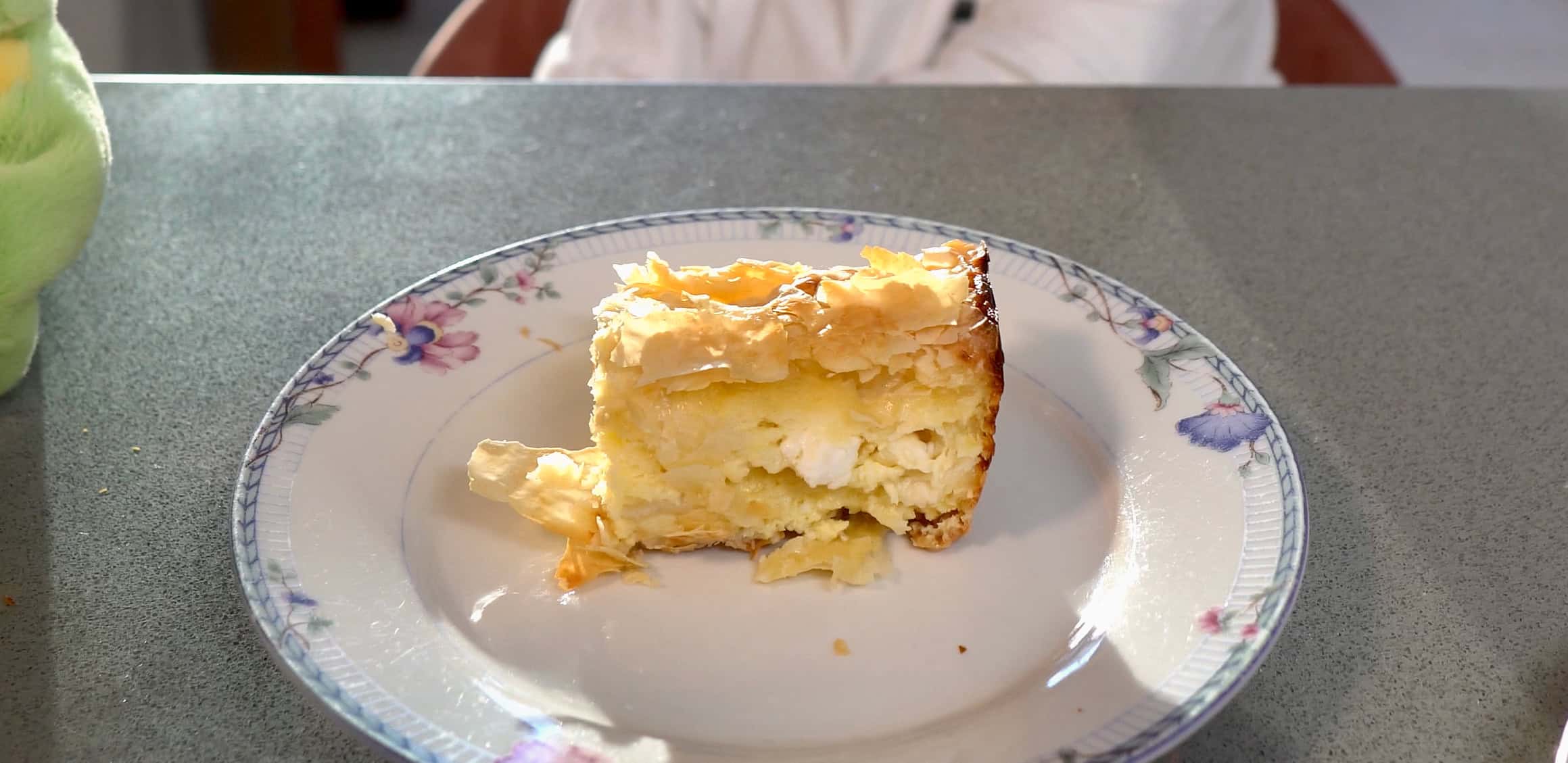Banitsa: Making Baba’s Recipe

I married into a Bulgarian family. One of the first Bulgarian dishes they had me try was banitsa. My wife has made the recipe below many times. Her mother, our son’s Baba (“grandmother” in Bulgaria), gave it to her.
This time I tried to make it. I’ll let you judge whether I lived up to the high Bulgarian standards for this national dish. For the uninitiated, let’s review what banitsa is and what some of those high standards entail.
What is Banitsa?
Aside from dishes like shopska salad and many others we enjoy during our trips to Bulgaria, banitsa is one of the most traditional Bulgarian dishes. It’s a pastry that strikes the perfect balance of flaky and crispy layers of phyllo dough with rich and creamy fillings of yogurt, eggs, feta cheese, and butter.
Banitsa is designed similarly to Italian lasagna. Think of the phyllo dough like the noodles and the creamy filling of yogurt, eggs, etc. like the sauce. Phyllo dough provides a base to build upon with the egg mixture and butter. We repeat this process multiple times until we have a thick pastry that’s ready for the oven.
When baked, the pastry transforms into golden-brown deliciousness with a delicately crunchy top and a soft, savory interior. Bulgarians enjoy this dish for breakfast with coffee or really at any other time of the day: lunch, snack, and even dinner. It’s also traditionally served on many special occasions like holidays and family gatherings. Few foods have a more special place in Bulgarian cuisine.
What is the Secret to the Best Banitsa Recipe?
The secret to perfecting this pastry lies in the careful layering of the phyllo dough sheets, the egg mixture, and the butter. The best banitsas are thick with distinct layers. They have a beautiful combination of a soft savory richness on the inside and a crunchy exterior on the outside.
Banitsa should not be flat. Baking soda helps it rise, but some Bulgarian babas may even use secret ingredients like sparkling water to help it along. Although be careful — you don’t want a runny or watery pastry (it won’t have any crunch!).
The true beauty of this dish lies in its versatility. It can be made in multiple variations. Some Bulgarians even add fillings like pumpkin!
Banitsa Variations
Arguably the most traditional way of making banitsa is by rolling phyllo dough up with the filling (i.e., egg mixture) instead of layering it as we have done in the recipe below. I saw it both ways during our travels through Bulgaria, but in our family, we make the layered version. There are a few reasons why.
The first is time. It’s faster to layer frozen phyllo dough with the egg mixture and butter than it is to roll it up into the phyllo dough.
The second is difficulty level. It’s easier to break up the phyllo dough into layers as opposed to rolling it, which takes practice and patience (perhaps I’ll try this next!).
The final reason is texture and flavor. Personally, most of us enjoy the different textures in the layered banitsa as opposed to the rolled version. But they are both delicious.
Below are a few other variations I have seen:
- Pumpkin banitsa – roasted pumpkin, eggs, and feta
- Spinach Banitsa – filled with a mixture of spinach, feta, and eggs.
- Meat Banitsa – contains a savory filling of ground meat, onions, and spices.
- Sweet Banitsa – filled with apples, walnuts, or sweetened cheese
Any of these variations can be made to the recipe below by including the extra fillings when combining the egg mixture.
The Banitsa Recipe I Used (From Baba)
The recipe I used has been passed down through the Bulgarian side of our family. My wife’s aunt uses it, and I’m pretty sure my wife’s baba used it too. The only “secret” I didn’t use from their recipe was sparkling water because I was afraid it would get too watery, but next time I’ll try it to see if it gets even fluffier!
Although as you’ll see from the video and recipe below, my first attempt at making the recipe by myself worked pretty well – the pastry came out fluffy, thick, and juicy!
I hope you enjoy this recipe as much as I do.

Bulgarian Banitsa
Ingredients
- 1 Box Frozen Phyllo Dough
- 2 Cups Greek Yogurt Non-fat and no flavoring
- 1/2 Tsp Baking Soda
- 1 Stick Butter Needs to be VERY COLD and diced into small squares
- 2 Cups Feta Cheese Crumble it (do not buy pre-crumbled)
- 5 Large Eggs
Instructions
- Preheat oven to 400 degree Fahrenheit
- Break apart phyllo dough a large bowl and set aside
- Combine yogurt, baking soda, feta, and eggs in a large mixing bowl and set aside ("egg mixture")
- Take 1/3 phyllo dough and cover bottom of a buttered pan
- Layer half of egg mixture with yogurt and baking soda
- Add 1/3 of chopped butter on top of the layer of egg mixture
- Add another 1/3 of phyllo dough
- Adding remaining half egg mixture
- Add another 1/3 of chopped butter
- Add final 1/3 phyllo dough
- Add remaining chopped butter on top
- Bake for 30 minutes in 400 degree Fahrenheit oven
- Remove from oven once browned and solid, and let rest for about 30 minutes until it is near room temperature



0 Comments